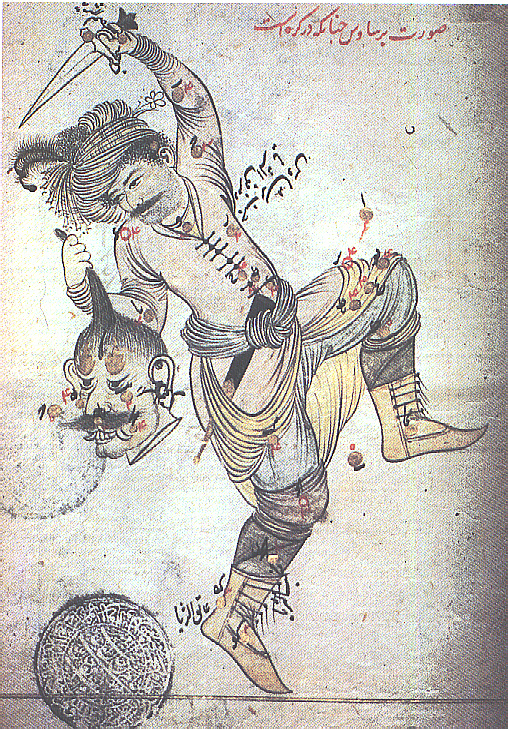 To learn more about the Native American and Polynesian use of stars for navigation,
explore the following links:
To learn more about the Native American and Polynesian use of stars for navigation,
explore the following links: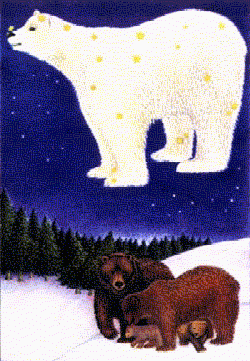 In addition to time-keeping, the early humans also realized that the fixed pattern
of stars could be used a navigational aids. We are all know of, for example, the
Big Dipper, one of the most familiar constellations of the Northern Hemisphere.
It comprises part of the constellation known to the ancient Greeks as Arktos, the Bear,
and later to the Romans as Ursa Major, the Great Bear. Of the seven stars constituting the
Big Dipper, six are of the second magnitude and one is of the third magnitude. Two of the
second-magnitude stars, Alpha and Beta Ursa Major, point directly to the North Star, Polaris,
and hence are called the Pointers. Before
wide-spread use of compasses and the advent of clocks that could keep time
on the oceans, knowledge of how to use the stars and the planets for orientation, a
skill or art that we now call Celestial
Navigation, was essential for long distance
land travels (particularly in the vast desert-like regions along the trade routes in
Asia (eg the Silk Route) as well as for travel on open waters out of sight of land.
The Odyssey of Homer, for example, refers to the
constellations and describes how the stars could serve as guiding beacons; right up
to the middle of this (first) millenium, Celesial Navigation was the most
reliable form of navigation for much of the world's population. Open ocean
sailors, such as those that plied the Indian and Pacific Ocean, created detailed
star maps in their minds and elaborate ways of remembering them. Polynesians and
Micronesians navigators, for example, used elaborate visual images--darting parrot fishes
or trigger fish or even the circular base of a gourd, lines burnt in to show the meridian of
Hawaii.
In addition to time-keeping, the early humans also realized that the fixed pattern
of stars could be used a navigational aids. We are all know of, for example, the
Big Dipper, one of the most familiar constellations of the Northern Hemisphere.
It comprises part of the constellation known to the ancient Greeks as Arktos, the Bear,
and later to the Romans as Ursa Major, the Great Bear. Of the seven stars constituting the
Big Dipper, six are of the second magnitude and one is of the third magnitude. Two of the
second-magnitude stars, Alpha and Beta Ursa Major, point directly to the North Star, Polaris,
and hence are called the Pointers. Before
wide-spread use of compasses and the advent of clocks that could keep time
on the oceans, knowledge of how to use the stars and the planets for orientation, a
skill or art that we now call Celestial
Navigation, was essential for long distance
land travels (particularly in the vast desert-like regions along the trade routes in
Asia (eg the Silk Route) as well as for travel on open waters out of sight of land.
The Odyssey of Homer, for example, refers to the
constellations and describes how the stars could serve as guiding beacons; right up
to the middle of this (first) millenium, Celesial Navigation was the most
reliable form of navigation for much of the world's population. Open ocean
sailors, such as those that plied the Indian and Pacific Ocean, created detailed
star maps in their minds and elaborate ways of remembering them. Polynesians and
Micronesians navigators, for example, used elaborate visual images--darting parrot fishes
or trigger fish or even the circular base of a gourd, lines burnt in to show the meridian of
Hawaii.
 To learn more about the Native American and Polynesian use of stars for navigation,
explore the following links:
To learn more about the Native American and Polynesian use of stars for navigation,
explore the following links:
![]() Native American Astronomy
Native American Astronomy
![]() Polynesian and Micronesian Celestial Navigation
Polynesian and Micronesian Celestial Navigation
As noted in the latter of the two websites, "Arab Indian Ocean navigators, on the other hand, used sounds--relying on poetic verses--to remember the stars and their position." In fact, it would seem that the use of stories and poetry to remember the various constellations in the sky and their relative positions was a common feature of the Near/Middle East and Mediterranean civilizations. These stories or mnemonic devices in time became entwined with existing stories and legends or may have even taken on a life of their own (so to say), and come down to today in the form of myths . The image shown here, from an Islamic astronomical manuscript shows the constellation of Perseus holding the head of the Medusa, whom he slew. Perseus is a well known character, a hero, in Greek Mythology. The constellation is part of the autumn/winter sky, appearing with some of the other characters in the myth. For example, Pegasus, the winged horse is next to Perseus and Cassiopeia, Cepheus and Andromeda are nearby too. (See sky-map for Victoria area sky map.)
In Greek mythology, Andromeda was the daughter of King Cepheus and Queen Cassiopeia. Her mother offended Poseidon, the god of the sea, by boasting that she and Andromeda were far more beautiful than any sea nymph. Cepheus, anxious to placate Poseidon, chained the unfortunate Andromeda to a rock by the seashore, to await her death at the hands of a sea monster, Cetus. However, the hero Perseus (on his way home after slaying the gorgon Medusa) rescued Andromeda in the nick of time, and later married her. The pattern of stars that make up the constellation Perseus was recognized by Ptolemy in the 2nd century AD.
![]() Perseus the Greek Hero is a Mayan Snake
Perseus the Greek Hero is a Mayan Snake
An interesting tidbit about the constellation of Perseus: In the head of Medusa, there is a binary star and the brighter of the two (the one visible by naked eye) visibly dims as it is regularly eclipsed by its companion. The Arabs called this star, Algol, the demon star or the twinkling eye of the Devil beckoning humans to stray from the path of Good.
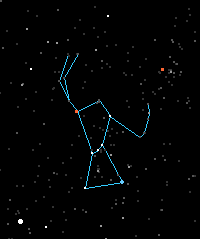 |
 |
There is another constellation of a warrior-hero Orion that is more
famous that that of Perseus and that,
because the stars that make up this constellation are among the brightest in the sky, dominates
the winter skies. Legends have described Orion's presence in the sky since the earliest days of
civilization.
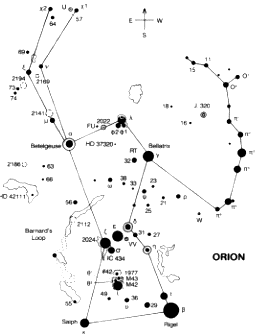 The Sumerians, who flourished from about 4000 to about 2000 BC, associated
the constellation
with their legendary king Gilgamesh. They pictured him fighting
a great bull, the constellation Taurus. To the ancient Egyptians,
the constellation was the pharaoh god Osiris, whose brother cut
him into pieces, hid the pieces in a box, and floated it down the
Nile River. The pharaoh's wife, Isis, supposedly found his
remains and flung the pieces into the sky, creating the
constellation. In Greek mythology, Orion was a great and
handsome hunter, and so the constellation is often called "Orion,
the Hunter." According to some legends, Orion was
punished for his arrogance. The Earth released a scorpion to
sting him, and Orion jumped into the sea. Because of their
enmity, the two were placed on opposite sides of the sky, which
is why the constellation Scorpius appears in the east just as
Orion sinks below the horizon in the west. A different story tells
of the love between Orion and the goddess, Artemis. One day, Orion was
swimming out in the sea. Apollo, who very much disliked the man, bet his
sister that she couldn't hit the object in the sea with
her bow. Artemis didn't realize it was her lover, and shot Orion with an
arrow. When she later found out what
she had done, she honored the hunter by putting him in the sky.
Ancient Indian mythology says the constellation was called
Prajapati. One day, Prajapati was chasing after one
of his daughters. The star Sirius was angered by this, and shot
an arrow at the lord. The arrow pierced his waist
and remains as his belt.
The Sumerians, who flourished from about 4000 to about 2000 BC, associated
the constellation
with their legendary king Gilgamesh. They pictured him fighting
a great bull, the constellation Taurus. To the ancient Egyptians,
the constellation was the pharaoh god Osiris, whose brother cut
him into pieces, hid the pieces in a box, and floated it down the
Nile River. The pharaoh's wife, Isis, supposedly found his
remains and flung the pieces into the sky, creating the
constellation. In Greek mythology, Orion was a great and
handsome hunter, and so the constellation is often called "Orion,
the Hunter." According to some legends, Orion was
punished for his arrogance. The Earth released a scorpion to
sting him, and Orion jumped into the sea. Because of their
enmity, the two were placed on opposite sides of the sky, which
is why the constellation Scorpius appears in the east just as
Orion sinks below the horizon in the west. A different story tells
of the love between Orion and the goddess, Artemis. One day, Orion was
swimming out in the sea. Apollo, who very much disliked the man, bet his
sister that she couldn't hit the object in the sea with
her bow. Artemis didn't realize it was her lover, and shot Orion with an
arrow. When she later found out what
she had done, she honored the hunter by putting him in the sky.
Ancient Indian mythology says the constellation was called
Prajapati. One day, Prajapati was chasing after one
of his daughters. The star Sirius was angered by this, and shot
an arrow at the lord. The arrow pierced his waist
and remains as his belt.
Historian of science, Giorgio de Santillana, has suggested that parts of the biblical narrative of the Story of Samson are in fact mnemonic devices for remembering the relative positions of other constellations using Orion (or Samson the Warrior) as the anchor. Consider the following elements of the story:
When he [Samson] came to Lehi, the Philistines shouted as they met him. And the spirit of the Lord came upon him mightily so that the ropes that were on his arms were as flax that is burned with fire, and his bonds dropped from his hands. |
Then he became very thirsty and he called to the Lord...God split the hollow place that is in Lehi so that water came out of it, when he drank, his strength returned and he revived.  Judges
15:14-19 Judges
15:14-19 |
It has even been suggested that the many of familiar elements of the biblical story of David and Goliath may have their origins in ancient Sanskrit stories associated with the stars and constellations. You can explore this possibility by perusing the article titled The Celestial David and Goliath . The concluding statement of the article reads:
I would conclude, then, that the story of the type, David slaying Goliath, or Lugh killing Balor, was a myth of the stars. The Celts, and most other nations of Europe and eastward to Persia and northern India, speak Indo-European languages derived from Sanskrit, a language spoken by a people who about 4000 BC burst westward from Central Asia in the Kurgan Invasion. The great antiquity of the Celtic gods has been shown by the presence of their names in Sanskrit. Certain gods of the Celts, as depicted on the Gundestrup Cauldron, bear a convincing resemblance to constellations of the northern sky. In particular, some figures - with their upraised forearms - look like the constellation Hercules, while Cernunnos or Lugh - with his folded legs - looks like Bootes. Lugh slew Balor by putting out his eye with a bolt from his sling, Corona Borealis. Balor is identified as Orion partly from his attribute of blindness, and partly from his name, Concubar, deciphered as Cupid, the bow-hunter. As a result of precession, Orion today is a slanted figure. Around 3500 BC he stood upright, so may then have been formulated as a constellation and named. At that time Bootes, low in the north on Lughnasadh, could bombard Orion with his bolt, a meteor forged by Hercules the Smith, and flung from the pouch which was Corona Borealis. In his heliacal setting Orion fell into the Otherworld. The myth of David and Goliath is an international folktale, found in nations from Ireland to India, and its motifs are listed in Thompson's classification of folktales.

|

|